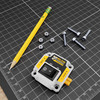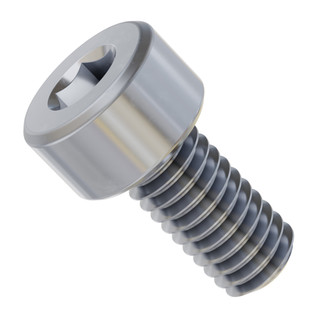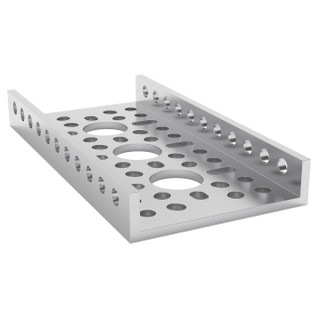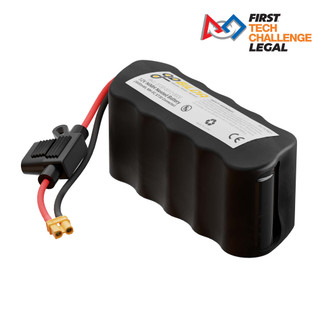Floodgate Power Switch (XT30, Current Sensing)
SKU:This product has a known issue that can, in rare cases, cause problems on certain robot designs, presenting as robot “disconnects." We’re taking several steps to ensure your team has a successful season and to turn this potential frustration into a better experience:
Account Credit: If you have purchased a Floodgate Power Switch from us, we’ve applied a $35 credit to your account to cover the cost. We believe you shouldn't be charged for something that doesn't perform as expected!
Code Fix: The PDF titled "Floodgate Issues Brief" in the Downloads section of this page contains a detailed testing procedure and a few lines of code which you can implement to allow continued use of your existing switch. It’s simple to implement and has no perceivable impact on performance.
Replacement Switch: If you have purchased a Floodgate Power Switch, we’ll be sending you a new version designed with an increased current limit that allows for spikes up to 80A. We have confidence that this increased limit will solve this problem for all robots. Once you receive the new switch, we kindly ask that you discontinue use of the current one to ensure your robot is running the latest and most reliable version. While keeping the code fix is fine, it won’t be necessary once the new switch is installed. We expect to start shipping replacement switches in early December.
Open the floodgates to more performance, data, and ease-of-use in your projects with the XT30 Current-Sensing Floodgate Power Switch! It’s a robust MOSFET-based rocker switch designed from the heft of FIRST Tech Challenge (FTC) experience in the goBILDA® R&D lab.
A Rocker Switch with (Almost) No Resistance
The power switches that are most commonly used in low-voltage robotics applications flow current through two strips of conductive material that move into and out of contact with one another based on the position of the “switch” that you interact with.
Those common “contact-based rocker switches” are bulletproof and simple—and they come with a key disadvantage: the contact formed by those strips is imperfect, and that imperfect contact creates an electrical resistance through which your battery voltage will “sag” more under load, and your batteries will die sooner! According to our testing, for example, a contact-based rocker switch sees 30mΩ of resistance, and since a new battery generally comes with an internal resistance value of 100mΩ, the addition of 30mΩ via a switch is significant.
This Floodgate Power Switch, however, doesn't rely on the switch you flip to carry the current! Instead, it commands the internal control architecture to activate a set of very powerful MOSFETs: extremely powerful metal-oxide-semiconductor field-effect transistors that allow current to flow only when commanded. These MOSFETs—which provide the magic behind many electrical gadgets you use day-to-day—add much less resistance than contact-based rocker switches. Compared to those switches’ 30mΩ internal resistance value, the MOSFET-based Floodgate only has 3mΩ, and this resistance will not increase over time.
Data and Protection Features
The Floodgate’s reduced resistance creates ultra-dependable brawn that comes with a suite of versatile and safety-conscious brains:
Smart Analog Current Monitoring
The Floodgate has a 0-3.3V analog output, which conveys the value of the current that is flowing through the switch. You can read this with a microcontroller or robotics control system to gain insight into the overall power draw of your robot and make smarter decisions about what to prioritize within your battery’s power budget.
A Fortress of Electrical Safety
When we packed the Floodgate with the most robust safety features we could imagine, we refused to settle!
- We massively over-designed the Floodgate’s electrical control architecture and MOSFET array. Its many smart features, and a dual MOSFET array capable of pushing over 400A of current, achieve a superbly high safety factor beyond what was required. It's absolutely glowing with safety, and that's why the Floodgate shines green to indicate "all systems nominal!"
- It boasts a 40A “smart” current limit. If 40A of current draw is detected across the switch for even 1µs, the switch will disable the output, and the lights will go from green to red. After 1 second, the switch will attempt to re-enable the output. This feature performs double-duty as a traditional current limit as well as short-circuit protection: if your wiring has a shorted circuit, the Floodgate will continue to retry to enable the output until the short is cleared. Each time the output is enabled for that smidgeon of time, the resulting smidgeon of current will flow to the short and keep your robot, actuators, wiring, and batteries safe, in spite of the short-circuit event.
- The Floodgate even rocks a 60A built-in fuse as a final protection method—if the current limit were to somehow fail, and the switch is continuously carrying more than 60A, this fuse will break.
Downloads
Specs
| Weight | 39g (including mounting hardware) |
|---|---|
| Included Hardware | 20mm Length M4 Socket Head Screw x 4, M4 x 0.7mm Nylock Nut x 4 |
| Input Voltage Range | 5V ~ 21V |
| Resistance | 3mΩ |
| Resettable Current Limit | 50A |
| Internal Fuse Rating | 60A |
| Current Draw (Output and LED Enabled) | 16mA |
| Current Draw (Output Enabled, LED Disabled) | 2mA |
| Current Draw (Output Disabled) | 0.0005mA |
| Power Input Connector | XT30 (FH-MC) |
| Power Output Connector | XT30 (MH-FC) |
| Current Sensor Connector | 3-Pos JST PH [FH-MC] |
| Current Sensor Analog Voltage Output | 0V ~ 3.3V |
| Current Sensor Max Measured Current | 50A |
































![3100-0006-0003 - (6V, 3000mAh, XT30 Connector [MH-FC], 20A Fuse, 6-3) 3100-0006-0003 - (6V, 3000mAh, XT30 Connector [MH-FC], 20A Fuse, 6-3)](https://cdn11.bigcommerce.com/s-x56mtydx1w/images/stencil/318x318/products/1163/5818/3100-0006-0003__25708__75076.1701992657.jpg?c=1)
